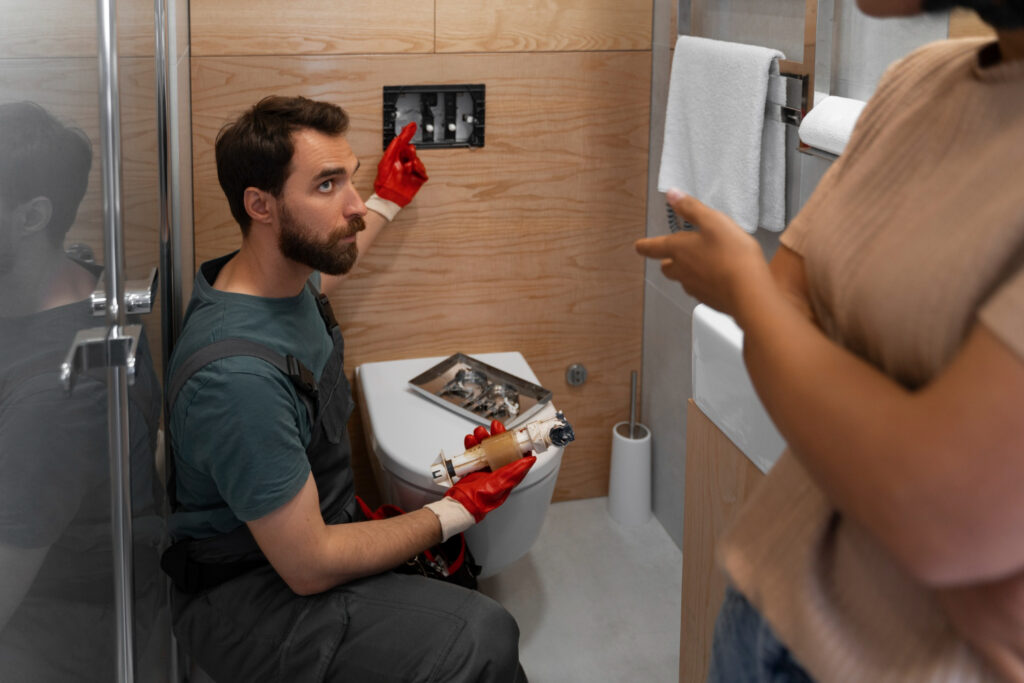Last Updated on 1 year by David Bergmann
Your move is coming up and you can’t wait to finally arrive in your new home. But take your pink glasses off for a second: Before you take over the apartment, you should definitely check for any damage or shortcomings. In Switzerland, it is usual to keep a handover agreement with your landlord before you move in. In the following article, you’ll find out, what you should pay attention to during apartment handover and why a snag list should be an integral part of it!
- Apartment handover agreement: Stay on the safe side!
- What shortcomings to look out for
- Snag list: Submission and deadline
- Repairs: What your landlord is obliged to do
- Damage noticed too late: What do I do now?
- Defects in the course of the tenancy
1. Apartment handover protocol: Stay on the safe side!
Ideally, you will discover any defects or damage to your new home during the first viewing or at the latest at the apartment handover. It is highly advisable to keep a handover protocol in which the current condition of the apartment and any existing defects are precisely documented (= Snag list)
Although a handover agreement is not required by law, it has some decisive advantages, especially for you as a tenant:
- The landlord or new tenant cannot hold you responsible for the damage when you move out.
- The landlord is responsible for repairing the damage and a deadline for this can also be agreed in the protocol.
- Documentation of meter readings (to avoid unjustified payments)
- Information and conditions regarding the rental deposit
2. What shortcomings to look out for
The apartment viewing should definitely take place in daylight and before you move in. It is advisable, not to set the move-in date too close to give the landlord time to repair any damage after the previous tenant has moved out.
You should pay attention to the following things during the apartment tour:
- Damage to floors (e.g. scratches or burn holes in the parquet)
- Mold on walls or floors (also check the grout between tiles!)
- Discoloration/yellowing on the walls (e.g. due to cigarette smoke)
- Windows & doors: Do they close properly? Are the seals OK or already brittle? Are there cracks in the panes?
- Holes (drill holes) and cracks in the walls
- Do all taps and the toilet flush work?
- Kitchen: Is there any damage to the fitted cupboards or worktop? Do all drawers and doors open properly? Do the electrical appliances work?
- Damage to the sanitary facilities (e.g. cracks in the toilet bowl)
- Damage to built-in furniture (e.g. front room cupboard)
Attention: Odor!
If you get a musty smell or cold cigarette smoke in your nose, you should think twice about moving into the apartment! Because the cause of the odors is often difficult to find and eliminate!

3. Snag list: Submission and deadline
During the handover of the keys, as mentioned above, an apartment handover protocol should be kept. Amongst other things, existing defects are also recorded in the acceptance report. When you move out, the snag list serves as proof that the damage was not caused by you. It is important that both the apartment handover agreement and the snag list are signed by you as the tenant and by the landlord/landlady.
You should submit the snag list as soon as possible after moving in, but no later than 30 days, so that you do not run the risk of being accused of causing the damage. Some landlords, especially larger property management companies, provide a template for the snag list, while others require you to draw up the document yourself. It is best to send the snag list by registered mail to ensure that it has actually been received.
When completing the snag list, you should describe the existing damage in as much detail as possible and ideally also attach photos for documentation purposes. As a general rule, it is better to record one defect too many than one too few.
Please note: If you only notice a shortcoming or damage later (after submitting the list of defects), you are still obliged to report it to the landlord.
4. Repairs: What your landlord is obliged to do
Not all damage or problems must be repaired by the landlord, but only those that prevent or hinder the contractual use of the apartment. If it is not a first occupancy (new build or core refurbishment), as a tenant you generally have to accept normal wear and tear (such as slight scratches in the wooden floor) from the previous tenants. In principle, it can be said that if the condition of the rented apartment deviates from the contractually agreed condition, this is a defect and the landlord must repair it.
These include, among others:
- Water damage or mold (serious defect!)
- Broken electrical appliances (e.g. dishwasher in the kitchen)
- Leaky windows and poorly closing doors
- Non-functioning heating system
- Broken/leaking shower hose
- Non-functioning sockets
- Toilet flush or tabs not working
Signs of wear and tear such as scratches in the parquet flooring or small cracks in the walls do not have to be repaired, but these should be noted in the apartment handover protocol as described above, so that you as the tenant cannot be held liable for them.
If the defects are minor, such as a faulty toilet flush or poorly closing window blinds, the landlord must repair these within the agreed period (apartment handover protocol).
In the case of major problems (e.g. mold), you should only take over the apartment with caution, if at all. This is important to secure your right to a reduction in rent or early termination.
5. Damage noticed too late: What do I do now?
Flaws can be manifold and many only become apparent after spending some time in the apartment. For example, noise or unpleasant smells from the neighbors are issues that are difficult to spot when viewing the apartment for the first time.
Nevertheless, these are impairments that reduce the quality of living and may entitle you as the tenant to a rent reduction.
In this case, you should first talk to the person causing the problem (e.g. neighbor). If that person won’t talk to you or the situation doesn’t improve, you should contact your landlord and ask for help. If he does not take action, you can demand a rent reduction.
If you are unsure, it is best to contact the tenants’ association, which can provide you with help and advice on all aspects of tenancy law. If there is a dispute with your landlord, the conciliation authority can initiate proceedings.
6. Defects in the course of the tenancy
In the case of issues that only occur after moving in, i.e. during the use of the rented property, the responsibility is not always entirely clear. In general, however, it can be said that all damages for which the tenant is not responsible (e.g. heating failure, burst water pipe, etc.) must be repaired by the landlord.

Please note: Immediately report any defects to the landlord or property management. Do not commission tradesmen on your own initiative without having clarified this with the landlord!
The first contact can be made by telephone or email; if there is no response, it is advisable to send a registered letter and set a reasonable deadline for rectification (e.g. 14 days).
If it is an emergency such as a gas leak, the relevant emergency services must of course be notified first. There is also imminent danger in the event of a burst water pipe, as water damage endangers the substance of the rental property and the entire building, and should therefore be repaired as quickly as possible.
Defects due to own fault
If damage occurs that you have caused yourself during the rental period (e.g. a burnt hole in the wooden floor or improper operation of an electrical appliance), you or your personal liability insurance (highly recommended!) must pay for it.
Minor repairs (up to approx. CHF 150) such as replacing defective light bulbs, tightening loose screws or replacing the filter of the extractor hood are part of the so-called “minor maintenance” and must be carried out by the tenants themselves.

Leave a Reply